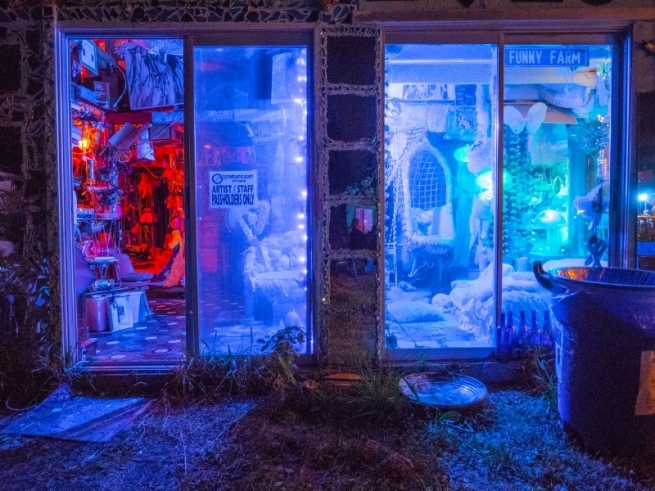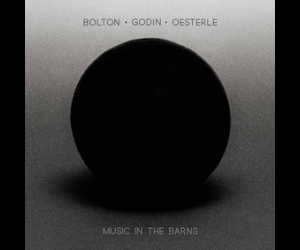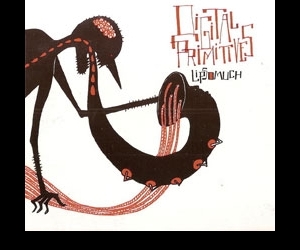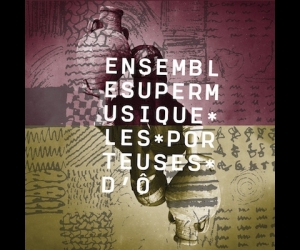
THE FIRST THING YOU NOTICE AT ELECTRIC ECLECTICS IS THAT YOU'RE NEVER REALLY BALANCED. The three-day midsummer festival of weird music and art takes place at Gordon Monahan and Laura Kikauka’s Funny Farm in Meaford, Ontario, which has hardly any level ground. The ground in front of the stage slopes away from it, not towards it; the music pulls you in, gravity pulls you down. It’s up to you to figure out which way you’re going to go.
The festival’s campsite, too, is tilted, as is the field on the far side of the forested area that turns into DJ Valley at night. The field becomes a haven at three or four a.m., when the music and the general scene become overwhelming.
The ground’s not the only thing askew. The backstage area is a fever-dream garage sale, where reclaimed furniture, objects, records, and games, washed in neon light, fill rooms that seem tacked on seemingly at random. This year, the stage featured a mannequin with two bags that read “In loving memory of Tony Conrad” and “1940-2016,” wearing a shirt adorned with the late violinist and filmmaker’s face and a loose hat fully covering its own. The DJ booth at the far left of the stage was made up to be a fireplace, while to the right of the stage was the usual pillar of impaled toys.
I say “weird” advisedly. Hifalutin’ approximations like “experimental” or “adventurous” can’t capture the almost cult-like energy of the place, the full-throttle manner in which the thing is done. A paradox of experimental art is that it eventually becomes familiar. At Electric Eclectics, everything—solo electropop, no wave, free-form improv, hip-hop, avant-rock, and noise—is fair game. And yet there is a definite unity of sensibility: nobody seems out of place. All the artists are so dedicated to their unique, individual aesthetics that there is a sort of convergence between them, a charting of common ground at the limits of experience and expression, all happening in the same incredibly bizarre setting.
Like Unsound Toronto, the other big weird music event in this part of the world, the venue is the star of the show. Toronto’s Hearn Generating Station and Meaford’s Funny Farm are two sides of the same coin: the one a vast, impersonal, postindustrial wasteland, the other elemental and human, all intimate performance and warm earth. There’s a dreamlike quality to both festivals: there is so much going on that the only thing to do is to follow your whim wherever it takes you and encounter things not as discreet art objects to be analyzed and critiqued but as forces of nature that command a certain awe. But whereas Unsound’s aesthetic of apocalyptic fantasy made palatable (read: corporate) pretends to be Millenarian but ends up merely millennial, Electric Eclectics is something different: a festival by and for the true believers. Whereas Unsound is a spectacle, Electric Eclectics is about spectacle deconstructed, its seams and wires and anxieties revealed, the resulting mess somehow becoming a spectacle in its own right: the spectacle of deconstructed spectacle.
It must be said that the previous year’s EE, the festival’s tenth-anniversary edition in 2015, had set a high-water mark. There is nothing quite like standing in a wheat field by Georgian Bay and suddenly hearing, from acres away but sounding as loud and clear as if it were coming from right next to you, Bill Exley booming out his intro for the Nihilist Spasm Band. That was followed by B L A C K I E jumping, rolling, and howling away, in his underwear on the lawn in front of the stage, making space for himself by lasso-swinging his microphone dangerously close to members of the audience, screaming “BIG BOYS ALWAYS WIN!” accompanied by an almighty roar of overdriven hip-hop beats coming from his iPod. Then came headliner Mykki Blanco, and somehow, a midnight experimental hip-hop show on a farm in Protestant, lily-white central Ontario, by a black genderqueer rapper dangerously swinging a ladder around on his back, adapting “Sweet Georgia Brown” in a verbally dexterous vaudeville riff on “Sweet Georgia [sic] Bay,” requesting and receiving unspecified drugs from the audience, and finally breaking down the performative barrier by manically jumping into a crowd that looked like an unseasonable Halloween party and grinding with anyone in sight, made perfect sense.
This latest, 2016 festival was more subdued than that—which is not to say it wasn’t still great. My contingent was in agreement that AH-MER-AH-SU, a self-described “black trans witch” from Oakland, California, was the festival’s highlight. Layering her voice to reach incantatory climaxes, with something of the vocal affectation of Antony and the sassy aphoristic wit of label boss Mykki Blanco, she built one song into a haunting rendition of “Ring Around the Rosie,” while other songs featured the timeless lines “You’s a little bitch and your friend’s a bitch too,” and “I’m a white woman. I can do what I want.”
The somatic electronic manipulations of Hexzuul and Mandelbrut were a first-day highlight. Accompanied by a giant robotic dancing ghost, my friends and I watched from chairs directly in front of the sound booth, which vibrated in response to the music. The facts that the chairs worked only sporadically and that my experience of the performance was therefore punctuated by tech-talk between my audio-engineer friend and the very friendly woman at the sound booth seemed somehow fitting. It’s not supposed to “work,” really.
It becomes almost de rigueur for performers to “activate the space” by encouraging audience participation. Bringing out dollar-store soundmakers, second-day favourites Bile Sister had half the audience participating at various points, complementing the band’s disjointed, glitchy electronic pop with whistling octaves from colourful noodles whirling above our heads. Scattered Clouds’ set, towards the end of day two, also played with audience interaction, but in a very different way. Beginning with a pretty entertaining sound check, the set comprised an impressive range of avant-rock styles before ending with something completely unexpected: an unchanging minimal guitar-and-drum pattern that seemed to go on forever. I’ve always felt as though endurance were a central part of the EE experience, from the two-and-a-half-hour drive up (forever, to a city-dweller) through the constant disasters that always seem to befall you, and on to the barrage of music and art and humanity at the festival. That song, coming at the end of a varied and tumultuous set, encapsulated the sentiment perfectly.
It seemed somehow fitting, all said, that I was so exhausted by the time headliners Lydia Lunch and Weasel Walter came on, that I had to retreat to my tent, hearing Lunch’s torrent of curses and litany of sexual escapades interspersed with Walter’s virtuoso drum-rolls from the comfort of my sleeping bag. Luckily, I recharged in time for DJ Valley and released the pent-up tension dancing to relentlessly upbeat Italo Disco, ending the night lying in the wheat field beyond the trees, watching shooting stars as the partiers danced on.
Those disjunctions—that feeling that, in not doing it right, you’re actually doing it perfectly—is part of what EE is about. Early on day one, a friend and I wandered into one of the truck-container art installations, Ottilie Mason’s Plastic Is Beautiful. We played around a bit with the microphones before Mason came out and offered us shots of her signature cocktail: marijuana-infused vodka. When we came back for the performance proper, later on, Mason read a poem that was funny but a little insubstantial and then tried to interview people, rewarding them with the same drink she gave us. It was much more interesting just wandering in the first time, not knowing what was going on, encountering it naively, person to person—which is really the point. Electric Eclectics is about more than just the music and art it presents: it’s about a mode of reception that makes room for the pure encounter—for pure, anarchic possibility.
Danger is an essential part of the equation. As safe and welcoming as EE is—one performance this year involved free dispensing of water for those in need, and though both Mykki Blanco and AH-MER-AH-SU pointed out the crowd’s relative ethnic uniformity, it is definitely a safe space for a diverse crowd in terms of other identity signifiers—it is nonetheless challenging, and the programming has no room for politesse. This is music, art, performance (the distinctions start to wither away) that hits you, confronts you, provokes you.
Even the weather plays along. Two years ago, we endured the worst hailstorm I’ve ever been in, just to get to the festival; and the final day of last year’s festival was blown out by, of all things, a tornado.
This year, we could see storm clouds on the horizon as we packed up to leave on day three. We stuck around for psych-jazz duo Not the Wind, Not the Flag, who meandered through a varied improvised set that transitioned from Coltrane-esque jazz to intense noise when Colin Fisher switched from saxophone to guitar and ended with drummer Brandon Valdivia joking around with a loop pedal. As I was leaving, I overheard someone say that he’d gotten his money’s worth many times over. I nodded in agreement.
Electric Eclectics 2o16 photo by: Matt Heckert


